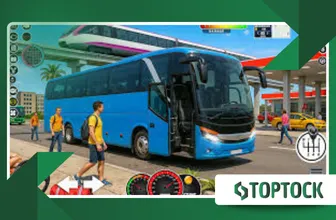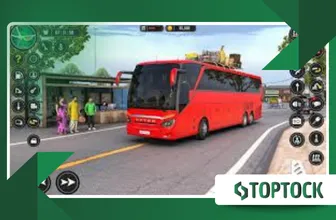Bus Simulator: Navigate Traffic and Keep Your Passengers Safe

The highly anticipated new iteration of Bus Simulator delivers an unparalleled experience, challenging players to navigate complex traffic while meticulously keeping their passengers safe and on schedule.
Anúncios
It’s a deep dive into the often-underestimated profession of a public transit operator, blending detailed vehicular physics with demanding logistical management.
What Real-World Skills Does Bus Simulator Test and Hone?
Operating a behemoth of a vehicle through dense urban environments requires immense focus and precision.
This simulation isn’t about speed; it’s about smooth braking, calculated lane changes, and maintaining a calm demeanor under pressure.
The core gameplay centers on defensive driving. Players must constantly monitor their surroundings, anticipating the erratic behavior of AI drivers and pedestrians alike.
Anúncios
It’s a virtual masterclass in spatial awareness and risk assessment.
Beyond driving, the game models the critical aspect of time management. Strict adherence to timetables, factoring in delays from traffic incidents or passenger boarding, becomes a strategic puzzle.
A delay at one stop compounds down the route, demanding intelligent decision-making to recover lost time safely. This pressure mirrors the daily reality for professional drivers.
How Does Advanced Traffic AI Elevate the Simulation Experience?
The quality of any driving simulation hinges on the realism of its traffic environment. Modern Bus Simulator titles have dramatically improved their AI models.
Vehicles no longer follow simple, predictable paths. They change lanes, react to sudden braking, and even cause realistic gridlock during rush hours.
This sophisticated AI means players encounter genuine real-world scenarios. Imagine approaching a four-way intersection only to find a delivery truck double-parked, forcing a quick, safe maneuver around it.
Such events demand improvisation and adherence to traffic laws, all while the clock keeps ticking toward the next scheduled stop. The constant demand for vigilance makes every route unique.
Why Is Passenger Safety the Ultimate Challenge in the Simulation?
A bus is a vessel for dozens of lives, and the simulation reflects this profound responsibility. Jerky acceleration or abrupt stops can lead to passenger discomfort or even virtual injury.
Smooth operation is rewarded, often through in-game scoring systems that track passenger happiness and ride quality. This mechanic directly ties driving technique to professional success.
Furthermore, the game integrates the need for accessibility. Managing wheelchair ramps, securing mobility aids, and assisting passengers reinforces the operator’s role as a public servant.
Read more: Goat Simulator: Wreak Havoc in the Most Absurd Simulation Ever
It adds a layer of empathy and responsibility, distinguishing the game from a simple racing title. It truly simulates a career, not just a vehicle.
What Are the Key Design Elements That Contribute to Hyper-Realism?
Modern simulators meticulously recreate city environments based on real-world locations or highly detailed fictional maps. This commitment extends to the vehicle models themselves.
Every dashboard control, from the air brake pressure gauge to the transmission selection, is often interactive and functional. Learning these complex interfaces is part of the appeal.
One example of this detail is the realistic wear-and-tear modeled on the buses.
Ignoring maintenance schedules can lead to mechanical failures mid-route, adding an unpredictable challenge.
Check this out: Truck
Another critical element is the realistic physics engine, particularly the suspension and weight distribution.
A bus handles fundamentally differently when empty versus when fully loaded with commuters.
This weight dynamic requires a complete adjustment of braking distance and cornering speed, a subtle but vital detail for dedicated simulation fans.
The Role of Data: Simulator Accuracy and Real-World Metrics
The fidelity of modern simulations is often backed by real-world data provided by bus manufacturers and transit authorities. This collaboration ensures accuracy.
According to a 2024 analysis published by the American Public Transportation Association (APTA), successful public transit operators show a 98% rate of on-time performance when utilizing predictive traffic data, a core mechanic in the game.
| Driving Metric | Beginner Score (Average) | Expert Score (Average) |
| Smooth Braking (Score 0-100) | 65 | 92 |
| On-Time Performance (Percentage) | 78% | 95% |
| Fuel Efficiency (Litres/100km) | 35 | 28 |
| Passenger Comfort (Score 0-10) | 5 | 9 |
This table illustrates the gap between a novice and a dedicated player, demonstrating that skill development is measurable and substantial.
Why Do Players Find Bus Simulator So Engaging and Therapeutic?
For many, the appeal lies in the structured, focused task of mastery. Like a complex puzzle, navigating a long, challenging route successfully provides a profound sense of accomplishment.
It offers a compelling alternative to high-octane action games, providing a meditative experience rooted in routine and execution. It’s a digital escape into responsibility.
++ Color Road
The challenge of maintaining a perfect schedule under pressure transforms routine into an exciting performance. It’s not just a drive; it’s a mission.
If a real-life driver can navigate a snow-covered route with zero incidents and perfect timing, shouldn’t they feel a rush of professional pride? The game captures that feeling.
The Future of Bus Simulator: Beyond the Current Generation
The trajectory for simulation titles points toward even greater integration with real-world technology. Imagine using a real-time weather feed to adjust driving conditions.
Future iterations will likely focus on enhanced career progression, sophisticated business management tools, and expanded multiplayer capabilities.
This will turn the simulation into a collaborative transit empire.
The commitment to realism will remain, ensuring that every time a player selects a route, they are engaging in a simulation of genuine, high-stakes responsibility.
The ultimate question remains: When confronting a sudden lane closure, are you capable of navigating the chaos and delivering your passengers safely, every single time?
This detailed and demanding virtual world makes Bus Simulator a powerful tool, providing both entertainment and a genuine appreciation for the transit professional.
It is a niche, but vital, sector of the gaming landscape.

A Newfound Respect for the Road
The latest Bus Simulator is far more than entertainment; it’s a meticulous study in patience, precision, and public service. It brilliantly captures the complexity of a crucial profession.
The game manages to be relaxing yet challenging, demanding focus and rewarding careful execution. It fosters a respect for the operators who master these tasks daily.
It’s a powerful experience that proves the most rewarding simulations are often those that mirror the most essential real-world jobs. The digital road awaits the next skilled operator.
Frequently Asked Questions
Is Bus Simulator suitable for casual gamers or only hardcore simulation fans?
The current generation of Bus Simulator titles offers scalable difficulty settings, making it accessible for casual players who want a relaxed driving experience and deep enough for hardcore fans seeking realism and challenge.
What is the primary objective of the game?
The main objective is to successfully manage and expand a bus company by driving various routes, adhering to schedules, maintaining passenger satisfaction, and managing the company’s finances and fleet.
Does the game feature real-world licensed buses?
Yes, modern versions of the game frequently feature officially licensed buses from major manufacturers like Mercedes-Benz, MAN, Setra, and others, ensuring authentic vehicle modeling and performance.
How realistic is the driving physics?
The physics are highly realistic, factoring in vehicle weight, speed, passenger load, road conditions, and the unique handling characteristics of large public transportation vehicles.
++ Driving Bus










